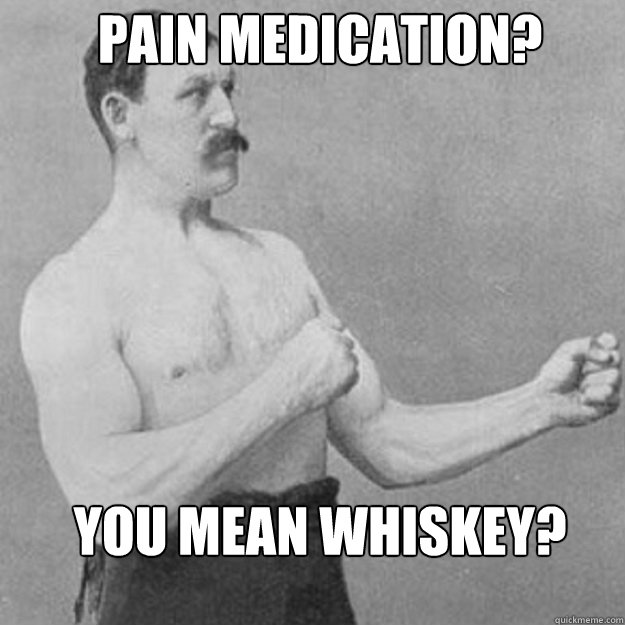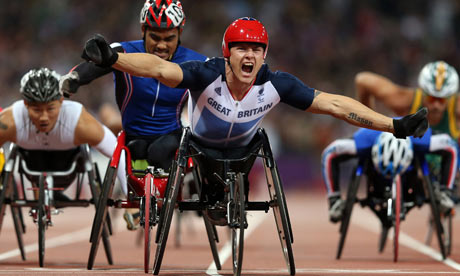Anyway, pain in EDS. There are a few
different headings, so I'll do my best:
- Muscles. Muscles ache because they work super hard to hold our silly bendy joints in place. Since we always have joints, this means that they always ache. On the Beighton scale, which measures hypermobility, I have a top score of 9/9 (something I have in common with many other EDS-ers). This basically means that my 9 most vital joints are affected, which also suggests that pretty much all my joints are bad. That's a lot of muscles that are very busy doing a job they're not meant to do - instead of allowing you to move, they're trying to hold you in place, which can lead not only to general aches but also to spasms, where the muscle completely seizes up, or tremors, where it shakes a lot. Stiff spasms and muscle shakes are exhausting and painful. Spasm is particularly difficult because every time you try to move it feels as if you're tearing the muscle in half. Sometimes you physically cannot move because the muscle is just too stiff. That's not too bad if the muscle in question is an arm or a leg, that you can just avoid moving - it's much harder when it's the intercostal muscles (those that go between ribs). When they're bad, it feels as if someone is stabbing you in the ribs every single time you take a breath. It's both painful and knackering.

Comes uncoloured; you colour in each muscle when you get a spasm... - Head. Constant headaches are a really common problem in EDS. I get a lot of migraines, although I also take medication daily which helps to prevent them. I've been on daily medication for migraines on and off since I was twelve, and I've tried loads of different types. Usually they work for a bit then they stop working and you have to try and find something else. I also have some nice strong painkillers to take for those occasions when I do get a migraine, but there's a very fine line between something which is effective enough for me and something which gives me really bad breathing problems and chest pain (tramadol!). I also have medication to deal with the nausea associated with migraine, although it can't actually stop me being sick if I need to. If you've never had a migraine, then all you need to know is that they're awful and you just feel like you want to die. I get massive pain in my head and in my eye (usually the left side). I can barely open my eyes and I can't move the eye in the socket because it hurts too much. I can't see properly, and I can't hear properly. I'm massively sensitive to smells and sounds, and even the slightest noise can make me need to be sick. Usually the only way that I can handle a migraine is to lie down in a dark and very quiet room and try to sleep it off. If I feel one coming on I can sometimes prevent it by getting something to eat and drink, taking some painkillers, and lying down for a bit. Often this doesn't work and I just go into extreme pain and sickness mode. These days I get migraines like this a few times a month. In the past I was getting them every other day. They really affect productivity and general quality of life! Of course, migraines aren't the only type of headache that EDS-ers can get, and you don't have to have EDS to get a migraine - it just seems to be pretty common.

I wish my headaches were this adorable. - Joint pain. This is separate to muscle pain because the muscles hurt in between joints, but you also get severe pain within the joints themselves. This can involve any tissue found in a joint. The pain can come from injury (whether acute or chronic, both of which are daily problems in EDS) or from the fact that it simply isn't shaped properly - for example, lots of EDS-ers have bones that aren't shaped properly at the ends, which can cause a lot of problems. It puts more strain on the joint and increases the risk of dislocation or subluxation (partial dislocation). EDS introduces you to pain in joints that most other people aren't even conscious of, and it can be really disabling, because the natural inclination is not to move a painful joint. My worst joints are in my spine (not helped my serious lumbar fracture, aged 13), both wrists and my fingers (too many years of playing musical instruments), my left hip, both knees, ankles and bones in the feet, both shoulders, and my TMJ (temporomandibular joint, or jaw in laymen's terms!). This doesn't mean I don't get problems with my elbows or my right hip - I do, just not as often as the others mess me around! The pain I have every day in these joints, coupled with the muscular pain, explains some of why I need my crutches or my wheelchair.

This person has pain in all these places. Amateur! - 'Innards'. Visceral problems (problems with bodily organs) are common in EDS. I get pain in my stomach and intestines quite a bit, although I'm luckier than some because I can at least still eat naturally without needing a tube. It's not particularly pleasant though, and you need to be able to run to a loo in case the combination of dodgy stomach and pain gets overwhelming! I also often get heart palpitations, especially if I'm feeling a bit under the weather. These aren't necessarily painful but they can become so if you ignore them for too long. Infections are often worse for EDS-ers, so a throat infection may reach the lungs. I'm lucky that I've not had that so far (touch wood!) but I have had infections in the trachea, which can really affect your breathing and give you bad chest pain. One big consequence of pain coming from the torso is that it can make you feel even worse than 'regular' muscle or joint pain. For example, if your stomach aches and your intestines feel as if they're trying to squeeze a bowling ball through them then you won't really want to eat much, which won't help you in the long run! These internal pains are really difficult to deal with, because other people can't necessarily see them, even though to you they are huge.

That's not good... - Skin hypersensitivity. Sometimes, just existing is really painful. You might be having a good day in terms of pain in the muscles/joints/stomach etc., but for some reason you just can't bear the touch of anything on your skin - it's too painful to wear a jumper. You might get into the shower and realise that the feel of the water going onto your face is too painful to cope with. This is so annoying! It feels completely ridiculous and since it isn't really socially acceptable not to wash or not to wear clothes you just have to get on with things. But can you imagine how painful it is if someone brushes past you on a train, when even wearing a coat is causing you immense pain? It sounds silly, and it is silly, but then EDS-ers aren't meant to be normal.

No further comment needed. - Neural pain. Now, this is really hard. Lots of people with EDS have some neural pain, but a lot more research is needed into neurological symptoms in EDS. Pain coming from the nerves can be unpredictable (earlier today, I picked up the loo roll in the bathroom and caught a nerve in my hand which was sooooooo painful and made me drop the loo roll in the bath!). It often feels like an electric shock - which isn't pleasant at all. It often comes on from the slightest things (really, how heavy is a loo roll?!). On the other hand, it can be more of a consistent thing. Some of the neurological symptoms I have had are: intense feelings of burning on the skin - as if someone has poured boiling water over me; electric shocks running down the arms or legs, and often going over my head and down both arms; stabbing feelings, often in the hands and feet; tingling, pins and needles or numbness in any part of the body; random twitches of arms and legs which can be violent; feeling as if I'm wearing a very tight glove or very tight socks - a painfully constricting feeling that can lead to numbness; feeling as if there are little creatures marching up and down on my skin, or just underneath it; muscle fasciculations under the skin; permanently twitching nerves (e.g. a nerve on the side of my hand twitched all day, and my eye twitched for over a month); and probably many more that I can't think of off the top of my head! Neurological symptoms are by definition involuntary. They're really annoying and especially so when you are trying to get to sleep but can't stop your leg from jumping up and down. They drive me bonkers and can also massively affect your strength in the affected part of your body - so, for example, when the nerves are bad in my arms I can't hold my arms up to brush my hair, put a jumper on, reach things off shelves, etc., nor can I grip things which is really the basis of doing most things that humans ever want to do. Simple every day tasks like getting dressed, eating a meal, having a shower and opening a door become really tricky.

Better in the sky than in your body!
I said I'd write about why I'm talking about pain today, so that's the next bit:
Having had my arm feel a bit better, yesterday I tried to push myself around a bit in Sopwith, my wheelchair. Big mistake! It felt OK at the time in my bad arm, although the grip in the hand was really weak so I needed some help. However, later in the evening it was apparent that my bad arm was substantially worse than it had been before (the good arm was fine, so I know it wasn't just a fitness thing). It has now seized up a lot and the nerve problems are really bad again. It's really painful all the way round from hand to shoulder. Today is also more painful than usual for my legs and my back, so I am struggling a bit. That's why I thought I'd write about pain.
So, why do I feel OK about pain? Surely that's a really perverse outlook?
The simple fact is that I also have bipolar disorder, which has caused me more pain than anything that EDS has managed. With EDS I have had dislocations, subluxations, fractures, breaks, more sprains and muscle/ligament tears than I can remember, constant muscle spasm, nerve problems, difficulty breathing, difficulty eating, difficulty thinking through a migraine or looking out of eyes I can't open, BUT all of these things pale compared to the pain of bipolar disorder.
 |
| This is not quite what it's like. Polar bears are good though. |
Bipolar made me want to die. It made me not want to see people I cared about ever again. It made me believe that the people I loved hated me. It stopped me from eating, it stopped me from going out, it stopped me from knowing what was real and what was not. Most of all, it stopped me from being me. I ceased to be myself because my brain had been taken over by something which had nothing to do with me. It was like I was possessed.
EDS has never done that. EDS challenges me on a daily basis. EDS is a huge part of me - it is quite literally in my DNA! - but it has never taken me over. It has never been more than me in the way that bipolar was.
For the last few years, I've been able to sort my life out a bit thanks to lithium, which is something of a wonder drug (if a last resort drug) for people with bipolar. I still take it, and I'm still grateful for it. By massively diminishing the problem of bipolar, lithium has given me the strength to tackle EDS, which in turn gave me the strength to tackle para-rowing, riding for the disabled and wheelchair racing - not to mention postgraduate study and everyday life.
 |
| The ironically volatile lithium. |
Physical pain is hard. It's tiring. It can make me vomit, or make me pass out. Sometimes it makes me cry. It stops me from going out and doing the things I'd like to do, and it stops me from being as helpful to others as I would like. But the thing is that, however much pain I'm in, I'm still me. When I had bad bipolar, I wasn't me. Retaining a sense of self is the most important thing you can do to secure your happiness - because how can you be happy when you aren't you? If there isn't a 'you' in existence, it follows that it is impossible for you to be happy. Sure, you can't be sad either, but you can't be happy. You can't be anything. Your body exists physically, but it is independent of you.
 |
| Excuse shaky hand - meds. |

















